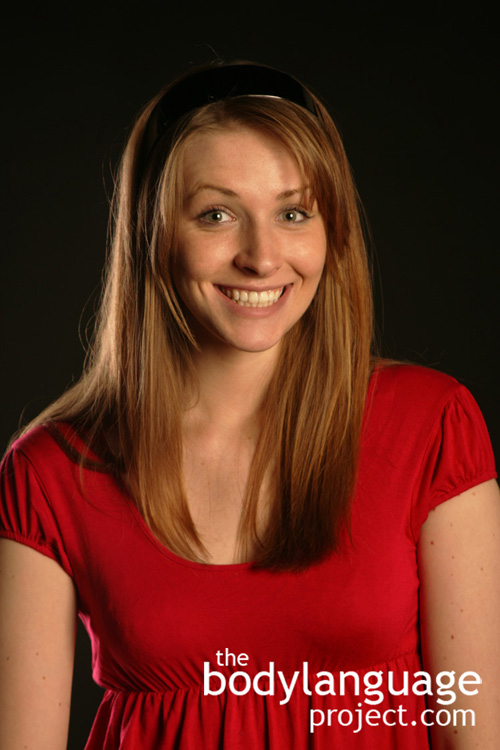Body Language of The Eyebrow Flash
Synonym(s): Raising The Eyebrows, Eyebrow Pop, Popping The Eyebrows.
Description: A rapid raising and lowering of the eyebrows in unison usually happening when seeing someone we recognize. The eyebrow flash happens very briefly and lasts only about one-sixth of a second.
In One Sentence: The eyebrow flash is a nonverbal hello indicating that a person has been recognized.
How To Use it: Use the eyebrow flash when greeting close friends. If you notice someone else perform the eyebrow flash, you should assume that they have recognized you and you should try to place them as best possible, but if not, go with it, as it is likely that they are not feigning the expression.
You can use the eyebrow flash during speech as well. It is a way to keep your face expressive as you relay information.
Context: General.
Verbal Translation: “Hey, I see and recognize you and I’m showing you that I know you by flashing my eyebrows quickly in a nonverbal hello.”
Variant: See Eyebrow Cock, Eyebrow Hold, Eyebrow Lowering, Eyebrow Raise, Eyebrows Knit or Oblique Eyebrows Of Grief.
Cue In Action: At the super market Dave recognized one of his classmates from high school. He flashed his eyebrows as they passed and was about to strike up a conversation, but the flash was not reciprocated. He quickly choked up his words for fear he had mistaken him for someone else.
Meaning and/or Motivation: The eyebrow flash has been studied for decades most notably by Eibl-Eibesfeldt. It has been shown to be a long distance universal social greeting. Even monkeys and apes have been shown to use raised eyebrows. It is a sort of nonverbal “Hello, I see you.” There are times when the eyebrow flash can happen so subtly that it is barely noticed but it is a clear sign of acknowledgment.
In Japan the eyebrow flash is considered rude and inappropriate due to its sexual connotation.
Raised eyebrows can also signal agreement, surprise and fear, but will vary from the quick eyebrow flash and appear in different context and will other cues.
Cue Cluster: The eyebrow flash will occur as people approach one another such that the eyebrows are visible but not so close that conversation is possible. Usually a slight wave is given, head nod or other greeting gesture.
Body Language Category: Automatic gesture, Greeting gesture, Nonthreatening body language, Open facial gestures, Universal gestures, Recognition gestures.
Resources:
Grammer, Karl ; Schiefenhövel, Wulf ; Schleidt, Margret ; Lorenz, Beatrice ; Eibl eibesfeldt, Irenäus. Patterns on the Face: The Eyebrow Flash in Crosscultural Comparison. Ethology. 1988. 77(4): 279-299.
Hall, Judith ; LeBeau, Lavonia ; Reinoso, Jeannette ; Thayer, Frank. Status, Gender, and Nonverbal Behavior in Candid and Posed Photographs: A Study of Conversations Between University Employees. Sex Roles. 2001 44(11): 677-692.
Martin, David John. 1997. Slaughtering a sacred cow: The eyebrow flash is not a universal social greeting. Dissertation Abstracts International: Section B: The Sciences and Engineering 58(5-B): 2751.
Moore, Monicam. Human Nonverbal Courtship Behavior—A Brief Historical Review. Journal of Sex Research. 2010 47(2-3): 171-180.
Moore, Monica. Courtship Signaling and Adolescents: Girls Just Wanna Have Fun. Journal of Sex Research. 1995. 32(4): 319-328.
http://bodylanguageproject.com/articles/girls-just-want-to-have-fun-the-origins-of-courtship-cues-in-girls-and-women/
Navarro, Joe. 2008. What Every BODY is Saying: An Ex-FBI Agent’s Guide to Speed-Reading People. William Morrow Paperbacks.
Teixeira Fiquer, Juliana; Paulo Sérgio Boggio and Clarice Gorenstein. Talking Bodies: Nonverbal Behavior in the Assessment of Depression Severity. Journal of Affective Disorders. 2013. 150: 1114-1119.
http://bodylanguageproject.com/articles/using-nonverbal-behaviour-to-assess-depression-severity/
Watt, Roger ; Craven, Ben ; Quinn, Sandra. A role for eyebrows in regulating the visibility of eye gaze direction. The Quarterly Journal of Experimental Psychology. 2007. 60(9): 1169-1177.
Wheldall, Kevin ; Mittler, Peter. Eyebrow-raising, eye widening and visual search nursery school children. Journal of Child Psychology and Psychiatry. 1976. 17(1): 57-62.

